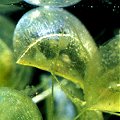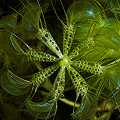Q: Aldrovanda: the waterwheel plant
A: Aldrovanda is a free-floating and rootless
aquatic plant. This plant is closely related to the Venus flytrap Dionaea muscipula, and shares
many of its attributes--it functions as a snap-trap carnivore, just under water!
A common name for it is the waterwheel plant because a single whorl of leaves, cut
from a stem, is wheel-like, as you can see to the right! The genus name commemorates the Italian naturalist
Ulisse Aldrovandi (1522-1605). In fact, the name for the genus was originally "Aldrovandia",
but Linnaeus misspelled this, and we use the incorrect spelling even today.
Each leaf in a whorl terminates in a little
clam-like trap. Exactly how the trap captures prey is a little complicated. Just like the traps of a Venus flytrap, the trap lobes of
Aldrovanda contain trigger hairs. When stimulated, these cause the traps to close. SNAP! The closure
takes about 1/4 to 1/2 second, which is impressive when you reflect upon the fact that the trap lobes must push water as they close.
If no prey is captured, the trap reopens in ten to twenty hours.
The strange snapping behavior of the plant was observed by De Sassus as early as 1861, but it was not until Darwin's
careful work was there proof it was probably carnivorous. We now know that indeed, the traps produce phosphate-digesting
enzymes, and that traps fed with radioisotope-labeled Daphnia absorb the prey.
Page citations: Darwin, C. 1875;
Fabian-Galan, G. & Salageanu, N. 1968; Juniper, B.E. et al. 1989; Lloyd, F.E. 1942;
Rice, B.A. 2006a.

